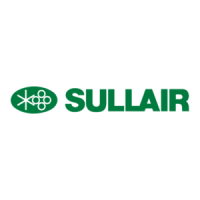Section 2
DESCRIPTION
6
ters and control valves. The inlet air filters are also
mounted for easy access and servicing.
2.3 SULLAIR COMPRESSOR UNIT, FUNCTIONAL
DESCRIPTION
Sullair tandem air compressors feature the Sullair
compressor unit, a two---stage, positive displace-
ment fluid lubricated---type compressor. This unit
provides continuous (pulse---free) air compression
to meet your needs.
Fluid is injected into the compressor unit in large
quantities where it mixes directly with the air as the
internal rotors turn, compressing the air. The fluid
flow has three basic functions:
1. As coolant, it controls the rise of air temperature
normally associated with the heat of compres-
sion.
2. It seals the leakage paths between the rotors and
the stator and also between the rotors them-
selves.
3. It acts as a lubricating film between the rotors al-
lowing one rotor to directly drive the other, which
is an idler.
After the air/fluid mixture is discharged from the
compressor unit, the fluid is separated from the air.
At this time, the air flows to the service line and the
fluid is cooled in preparation for injection.
NOTE
With a Sullair compressor, there is no mainte-
nance or inspection of the internal parts of the
compressor unit permitted in accordance with the
terms of the warranty.
2.4 COMPRESSOR COOLING AND LUBRICATION
SYSTEM, FUNCTIONAL DESCRIPTION
RefertoFigures2---2.Thecoolingandlubrication
system (air---cooled version) consists of a
fan, ra-
diator---type cooler/aftercooler assembly, full---
flow fluid filter, thermal valve, fluid stop valve
and
interconnection piping
. For water---cooled mod-
els, a
shell
and
tube fluid cooler, aftercooler
and
water---flow regulating valve
are substituted for
the radiator---type cooler on air---cooled compres-
sors.
The pressure in the receiver/sump causes fluid flow
by forcing the fluid from the high pressure area of
the sump to an area of lower pressure in the com-
pressor unit.
Fluid flows from the bottom of the receiver/sump to
the thermal valve. The thermal valve is fully open
when the fluid temperature is below 170
_
F (77
_
C).
The fluid passes through the thermal valve, the main
fluid filter and directly to the compressor unit where
it lubricates, cools and seals the rotors and the com-
pression chamber.
As the discharge temperature rises above 170
_
F
(77
_
C), due to the heat of compression, the thermal
valve begins to close and a portion of the fluid then
flows through the cooler. From the cooler, the fluid
flows to the fluid filter, and on to the compressor unit.
A portion of the fluid flowing to the compressor is
routed to the anti---friction bearings which support
the rotors inside the compressor unit.
The fluid filter has a replacement element and an in-
tegral pressure bypass valve. An associated service
gauge shows red when the filter needs servicing.
This gauge has a pressure setting lower than that of
the bypass valve. After the initial 50 hour filter
change, the gauge will rarely show red under nor-
mal operating conditions.
The fluid stop valve prevents fluid from filling the
compressor unit when the compressor is shut
down. When the compressor is operating, the fluid
stop valve is held open by air pressure from the
compressor unit allowing a free flow of fluid from the
receiver/sump back to the compressor unit. On
shutdown, the compressor unit pressure is re-
duced, causing the fluid stop valve to close and iso-
late the compressor unit from the cooling system.
Water---cooled versions of the compressor have a
water---flow regulating valve which operates to con-
serve water during periods of varying load on the
compressor. The same valve automatically shuts off
the water supply when the compressor is shut
down. In addition, water---cooled models have a wa-
ter pressure switch to prevent operation with inade-
quate water pressure.
2.5 COMPRESSOR DISCHARGE SYSTEM, FUNC-
TIONAL DESCRIPTION
RefertoFigures2---3.Thecompressorunitdis-
charges the compressed air/fluid mixture through a
discharge check valve into the combination receiv-
er/sump. The discharge check valve prevents air in
the receiver from returning to the compression
chamber after the compressor has been shut down.
The receiver has three basic functions:
1. It acts as a primary fluid separator.
2. It serves as the compressor fluid sump.
3. It houses the final fluid/air separator elements.
The compressed air/fluid mixture enters the receiver
and is directed against the far side of the tank,
where its direction of movement is changed and its
velocity significantly reduced. This causes large
droplets of fluid to collect, separate and fall to the
bottom of the receiver/sump. The fractional percent-
age of fluid remaining in the compressed air collects
on the surface of the dual separator elements (pri-
mary and secondary) as the compressed air flows
through them. Two return lines (or scavenge tubes)
lead from the bottom of each separator element to
the low pressure inlet region of the compressor unit.
Fluid collecting on the bottom of each separator is
returned to the compressor by a pressure difference
between the receiver and the compressor inlet.

